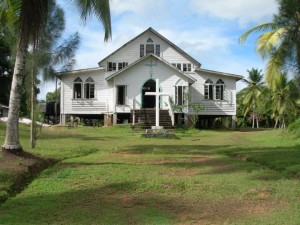
In Santa Rosa stands the well-known Santa Rosa Mission, also known as “White Chapel on a Hill”. It serves now for more than 100 years not only as a religious building but as a significant part of the Santa Rosa community, keeping it together.
In an interview with Jean Rodrigues, a resident of Santa Rosa who has since migrated but continues to contribute largely to the community, the history of the Catholic mission to the Amerindians of Guyana actually began in Venezuela.
Beginnings
Throughout the 18th century, Spanish Franciscans ministered to the indigenous people of territories around the Orinoco. Their mission however came to an abrupt and tragic end when on May 3, 1817, Simon Bolivar’s forces put to death 26 priests and two lay brothers. The Amerindians fled from the destroyed mission, some seeking refuge in the British held territory around the Moruca River.
The research continues to show that when the Arawaks of Moruca made their appeal for a priest, Providence had provided John Hynes to respond. In a letter written to a Dominican friend on June 6, 1830, Hynes expressed his concern for all the indigenous people of Guiana, saying, “Since my arrival in the colony I deeply lamented the condition of our much neglected Indian population, and sincerely wished to have the power and means of conveying to them the blessings of religion.”
He went on to recount how the Arawaks “hearing that a priest was in the colony, sent a white man (called Hilhouse) to me to say that they were Catholics, ever so long without any spiritual guide, and entreating me to afford them, if it be in my power, an occasional opportunity of assisting at the Divine Mysteries and getting their children baptised.”
Hynes welcomed this invitation with joy, and made arrangements to visit Moruca, setting aside 15 days for the round trip from Georgetown.
Hilhouse describes the historic encounter: “On the eve of the feast of Saint John (June 24, 1830) Mr Hynes reached their settlement in the dark woods and was received by them with many demonstrations of joy and affection. Muskets were fired as he approached, and on his landing, men, women and children flocked to kiss his hand in token of respect. It being night, the forest was illuminated with wax lights of their own manufacture.” During a 3-day visit, Hynes baptized 75 children and married two couples.
From this beginning, a mission was developed to other Amerindian communities in the North West.
Another mission centre was opened at Morawhanna, closer to the Venezuelan border, thus expanding the range of communities served by the priests of the North-West district.
Santa Rosa
Moruca had always been especially dear to Bishop John Hynes, and from 1840 until 1853 it had been well served by a much loved and respected resident Irish priest, Fr John Cullen. With Moruca as his base, this intrepid missionary had made numerous visits to outlying villages, even as far as the Orinoco.
Under his direction a new church had been built in Moruca, which was solemnly dedicated and opened by Bishop Hynes on October 27, 1844. The saint selected as patroness for this church was St Rose of Lima. From that day to the present, Catholics have referred to the Moruca community as “Santa Rosa”.
It is worth recording that in 1847 when the poor of Ireland were suffering the ravages of the potato famine, the Amerindian Catholics of Santa Rosa took up a collection on their behalf, sending $44.88 to the Irish and Scotch Relief Society.
On Cullen’s retirement through ill health in 1853, no resident replacement could be found. For a while the community received periodic visits from Fr. Francis Hayden and Fr. Joseph Fitzgerald OP, based at Abram’s Zuil on the Essequibo coast.
When James Etheridge arrived in 1857 he initially sent Benedict Schembri to Santa Rosa. Schembri arrived in December 1857 to find the church and presbytery in poor repair. He stayed less than a month before returning to Georgetown.
Fr de Bentham, based at Abram’s Zuil took on the care of the Moruca community, continuing the practice of making periodic visits. Negri, Baldini, Casano and Mesini, all of whom were at various times based at Abram’s Zuil, continued these visits to Santa Rosa.
In November 1876, Marco Mesini was able to increase the frequency of these visits to Santa Rosa, and in 1878 built a new church there. When Fr Thomas Barker arrived to take over Abram’s Zuil in 1888, Marco Mesini was finally free to move permanently to Santa Rosa, which had struggled for 35 years without a resident priest.
Etheridge did not live to see the new church built in Santa Rosa. After celebrating mass on Christmas morning in 1877, he set sail for Barbados. On the evening of December 31, while the ship was still at sea, he died. His body was committed to the deep in the early hours of New Years day in 1878.
Rodrigues mentioned with such rich history, the church continues to play a major role in the community of Santa Rosa. She pointed out that complete restoration of the church took place last year and in September 2012 a commemorative mass was held to celebrate the opening of the renovated “White Chapel on a Hill”. One of its current leaders is Fr. Wilian Montalvo.
She also noted that famous poet A.J. Seymour referred to it in his poem “Names” as “Santa Rosa- White Chapel on a Hill” and that is how it got its name “White Chapel on a Hill”.
For more information on early church history in Guyana visit www.guyanajesuits.org



